Inside the Fort: Meeting House
Introduction
Text-to-speech Audio
The Meeting House, along with the Trading Post, is one of two large, reconstructed buildings inside Pricketts Fort. It is used to interpret the work of homesteaders on the West Virginia frontier. Visitors can explore displays of equipment for making textiles, dyes, candles, soap, and other home items, representing the array of tasks that were required for survival on the frontier. A large hearth in the back of the Meeting House is also used for cooking demonstrations.
Images
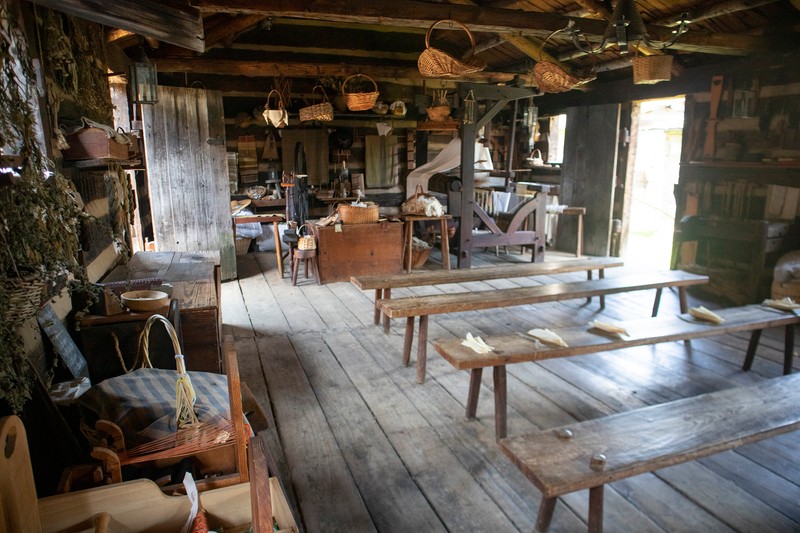
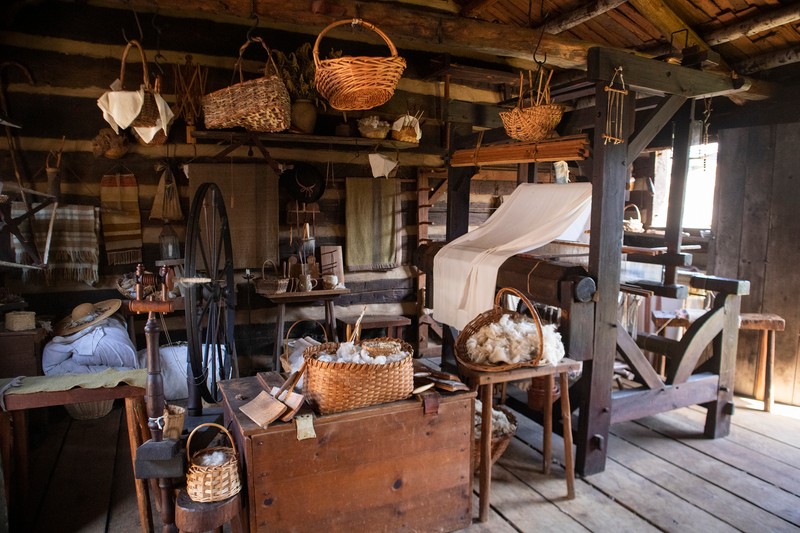
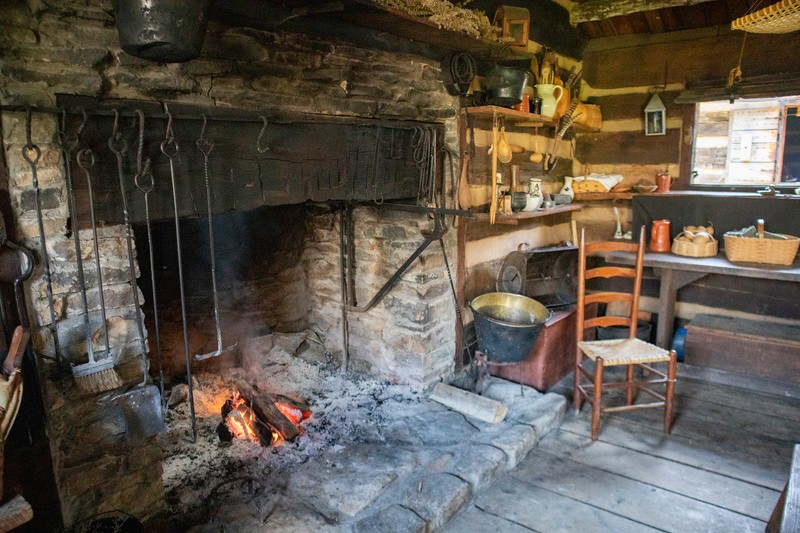
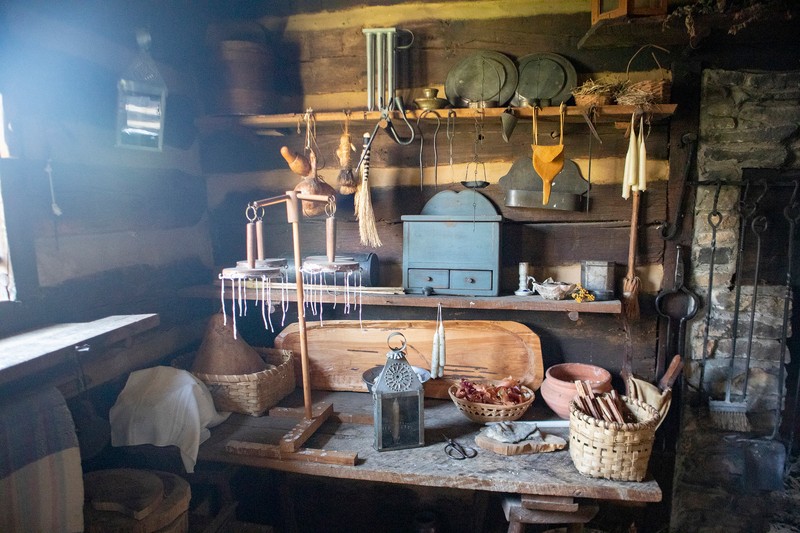
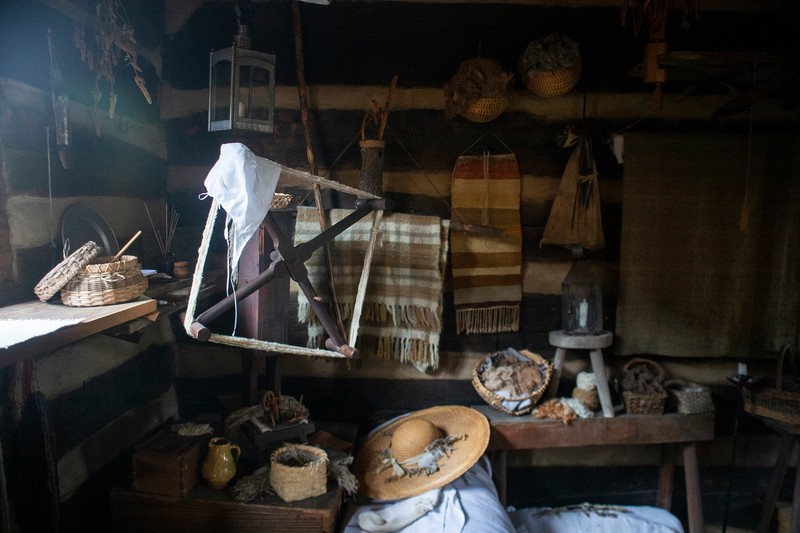
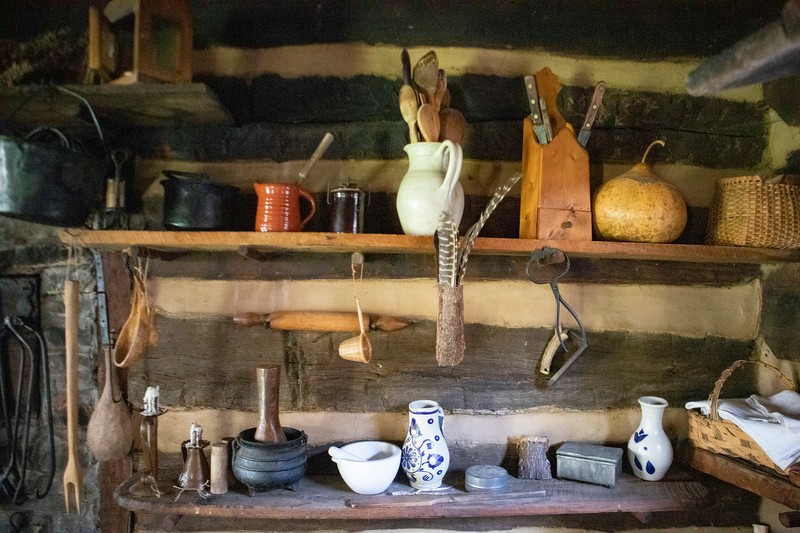
Backstory and Context
Text-to-speech Audio
Settlers on the West Virginia frontier had less access to ready-made goods compared to those in cities on the eastern seaboard. Therefore, families in West Virginia engaged in subsistence farming and often made items like clothing, candles, and soap by hand. Some settlers of German, Scots-Irish, and English ancestry brought knowledge and skills from Europe, while others had to acquire the necessary skills to survive on the frontier. Displays in the Meeting House at Pricketts Fort help represent this history.
Settlers including the Pricketts engaged in subsistence farming, cultivating enough food to meet their own needs but not enough to have a surplus to sell. They first cleared the land through slash and burn. Once they were more established, settlers improved their fields and pastures by removing tree stumps. Livestock such as cattle and hogs were free range, and fences were used around gardens to keep the animals out. Fenced-in gardens contained vegetables, medicinal herbs, and dyes, while corn and grains were cultivated in fields, sometimes shared by families and communities. In addition to agriculture, settlers gathered nuts, fruit, mushrooms, maple sap, and medicinal herbs such as ginseng from the forest. They hunted and trapped a variety of animals for meat and hides. Families cooked at large hearths where pots, dutch ovens, skillets, and grills were used simultaneously, similar to having multiple burners on a stove. These tasks were often delegated according to gender and age. While gender roles were not strictly enforced on the frontier because of survival, men and older boys worked in fields and hunted, while women, girls, and young children managed gardens and hearth cooking. Some families also used the labor of indentured servants from Europe and enslaved people of African descent.
Another essential resource was clothing. While those living in and around cities could purchase fabrics in the 18th century, many of which were being imported from Britain, settlers of more remote areas created their fabrics from scratch. Animals were hunted for their skins and furs, which were well-insulated, waterproof materials needed for spending time outdoors. Animal products were used to create outer layers of clothing like shirts and leggings worn by men, hats, and moccasins, as well as bags. Wool could be loosely spun and woven into heavy woolen, or worked into a soft felt. Woolens and felt provided trapped air and provided insulation from the chill of winter. Wool could also be spun and woven more tightly and smoothly into a fine, lightweight worsted wool. Worsted wool was worn any time of year, including summer, because it was breathable and more water-resistant. Linen, derived from the flax plant, was also a lightweight, breathable fabric, preferred most in the summer. All of these materials were highly functional and adaptable for settlers.
Creating woven textiles was a time-consuming process and entire families contributed to this work. In the spring, sheep were sheared and flax seeds planted, usually by men and older boys. Families, including young children, cleaned and scoured the wool to prepare for spinning. In summer, flax was harvested, a time-sensitive task that families or communities worked on together. The harvested flax was dried and “scutched,” a process that extracts the fine fibers from the plant. Once flax was scutched and wool combed with cards, the fibers could be spun on spinning wheels, a delicate skill led by women and girls. Finished yarn and thread could be dyed with natural materials. The Meeting House at Prickett’s Fort displays many textile production tools, including spinning wheels, wool cards, and a loom, as well as examples of dyed yarn.
Clothing styles on the West Virginia frontier varied according to an individual’s gender and age, but universally, clothing was made to work in. Wool and linen were durable fabrics that could endure being exposed to the weather, to physical labor, and even to sparks from a fire without much damage. Outer layers protected the skin from the sun, wind, scratches, bites, burns, and other injuries that could come from doing manual labor. Men wore breeches and women wore petticoats, shortgowns, and jackets. Accessories like neckerchiefs, long socks, and hats also provided protection. These outer layers were placed on top of undergarments, including long linen shirts for men and linen shifts for women, which is also what people slept in. The undergarments, as the item of clothing closest to the skin, were washed more often than the outer layers.
Soap-making was a difficult, even dangerous, process that required careful skill. The two main ingredients of historic soap were lye and animal fat. Lye is an alkaline substance made by filtering water through hardwood ashes and boiling down the liquid to just the right consistency - strong enough to chemically react with the animal fat, but not too strong that it would cause chemical burns. Animal fat, usually leftover from cooking, was rendered, melted, and mixed with water. The two ingredients were slowly combined over a fire, usually outdoors due to the heat and odor. Once cooled, salt was added to solidify the soap into bars.
Sources
Boback, John M. Pricketts Fort: A Bastion in the Wilderness. Pricketts Fort Memorial Foundation, 2005.
Boback, John M. "Commercialism, subsistence, and competency on the Western Virginia frontier, 1765-1800." Masters Thesis. (West Virginia University, 2000).
Gillespie, William H. "Wild Foods." e-WV: The West Virginia Encyclopedia. 19 November 2010. Web. 31 May 2022. https://www.wvencyclopedia.org/articles/1249
Hofstra, Warren. "Backcountry Frontier of Colonial Virginia," Encyclopedia Virginia, Virginia Humanities. December 7th 2020. Accessed May 31st 2022. https://encyclopediavirginia.org/entries/backcountry-frontier-of-colonial-virginia/
Park, Edwards. "To Bathe or Not to Bathe: Coming Clean in Colonial AmericaHemp & Flax in Colonial America." CW Journal. Autumn 2000. https://research.colonialwilliamsburg.org/foundation/journal/Autumn00/bathe.cfm
Rice, Otis K. The Allegheny Frontier: West Virginia Beginnings, 1730–1830. Lexington, KY. University Press of Kentucky, 1970.
Sperow, Charles. "Agriculture." e-WV: The West Virginia Encyclopedia. 04 September 2012. Web. 31 May 2022. https://www.wvencyclopedia.org/articles/166
Swenson, Ben. "Hemp & Flax in Colonial America." CW Journal. Winter 2015. https://research.colonialwilliamsburg.org/foundation/journal/Winter15/hemp.cfm
Wilcox, William J. Pricketts Fort: How and Why it Came to Be. Pricketts Fort Memorial Foundation. Reprinted 2011.
White, Kelly. "Good Old Fashioned Clean: Facts About Colonial Soap," Pennsbury Manor. May 13th 2020. Accessed May 31st 2022. http://www.pennsburymanor.org/good-old-fashioned-clean-five-facts-about-colonial-soap-by-kelly-white/ .
